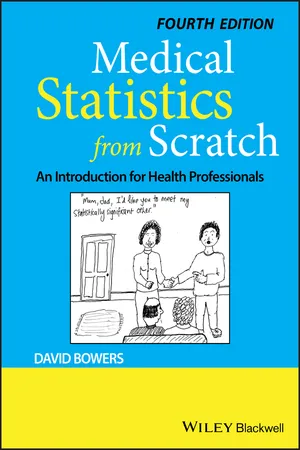
eBook - ePub
Medical Statistics from Scratch
An Introduction for Health Professionals
David Bowers
This is a test
Condividi libro
- English
- ePUB (disponibile sull'app)
- Disponibile su iOS e Android
eBook - ePub
Medical Statistics from Scratch
An Introduction for Health Professionals
David Bowers
Dettagli del libro
Anteprima del libro
Indice dei contenuti
Citazioni
Informazioni sul libro
Correctly understanding and using medical statistics is a key skill for all medical students and health professionals. In an informal and friendly style, Medical Statistics from Scratch provides a practical foundation for everyone whose first interest is probably not medical statistics. Keeping the level of mathematics to a minimum, it clearly illustrates statistical concepts and practice with numerous real-world examples and cases drawn from current medical literature.
Medical Statistics from Scratch is an ideal learning partner for all medical students and health professionals needing an accessible introduction, or a friendly refresher, to the fundamentals of medical statistics.
Domande frequenti
Come faccio ad annullare l'abbonamento?
È semplicissimo: basta accedere alla sezione Account nelle Impostazioni e cliccare su "Annulla abbonamento". Dopo la cancellazione, l'abbonamento rimarrà attivo per il periodo rimanente già pagato. Per maggiori informazioni, clicca qui
È possibile scaricare libri? Se sì, come?
Al momento è possibile scaricare tramite l'app tutti i nostri libri ePub mobile-friendly. Anche la maggior parte dei nostri PDF è scaricabile e stiamo lavorando per rendere disponibile quanto prima il download di tutti gli altri file. Per maggiori informazioni, clicca qui
Che differenza c'è tra i piani?
Entrambi i piani ti danno accesso illimitato alla libreria e a tutte le funzionalità di Perlego. Le uniche differenze sono il prezzo e il periodo di abbonamento: con il piano annuale risparmierai circa il 30% rispetto a 12 rate con quello mensile.
Cos'è Perlego?
Perlego è un servizio di abbonamento a testi accademici, che ti permette di accedere a un'intera libreria online a un prezzo inferiore rispetto a quello che pagheresti per acquistare un singolo libro al mese. Con oltre 1 milione di testi suddivisi in più di 1.000 categorie, troverai sicuramente ciò che fa per te! Per maggiori informazioni, clicca qui.
Perlego supporta la sintesi vocale?
Cerca l'icona Sintesi vocale nel prossimo libro che leggerai per verificare se è possibile riprodurre l'audio. Questo strumento permette di leggere il testo a voce alta, evidenziandolo man mano che la lettura procede. Puoi aumentare o diminuire la velocità della sintesi vocale, oppure sospendere la riproduzione. Per maggiori informazioni, clicca qui.
Medical Statistics from Scratch è disponibile online in formato PDF/ePub?
Sì, puoi accedere a Medical Statistics from Scratch di David Bowers in formato PDF e/o ePub, così come ad altri libri molto apprezzati nelle sezioni relative a Médecine e Biostatistiques. Scopri oltre 1 milione di libri disponibili nel nostro catalogo.
Informazioni
II
Descriptive Statistics
2
Describing data with tables
Learning objectives
When you have read this chapter, you should be able to:
- Explain what a frequency distribution is.
- Construct a frequency table from raw data.
- Construct relative frequency, cumulative frequency, and relative cumulative frequency tables.
- Construct grouped frequency tables.
- Construct a cross‐tabulation table.
- Explain what a contingency table is.
- Rank data.
Descriptive statistics. What can we do with raw data?
As we saw in Chapter 1, when we have a lot of raw data, for example, as in Figure 1.1 (birthweight) or Figure 1.2 (gender), it is not easy for us to answer questions that we may have; for example, the percentage of low birthweight babies or the proportion of male babies. This is because the data have not been arranged or structured in any way. If there are any interesting features in the data, they remain hidden from us. We said then that the data could not tell their story, and of course, the more data there are, the harder this becomes. Samples of many hundreds or thousands are not uncommon.
In this chapter, and the four following, we are going to describe some methods for organising and presenting the data, so that we can answer more easily the questions of interest – essentially to enable us to see what’s going on. Collectively, these methods are called descriptive statistics. They are a set of procedures that we can apply to raw data, so that its principal characteristics and main features are revealed. This might include sorting the data by size, putting it into a table, presenting it as a chart, or summarising it numerically.
An important consideration in this process is the type of data you are working with. Some types of data are best described with a table, some with a chart and some perhaps with both, whereas with other types of data, a numeric summary might be more appropriate. In this chapter, we focus on organising raw data into what is known as a frequency table. In subsequent chapters, we will look at the use of charts, and numeric summaries. It will be easier if we take each data type in turn, starting with nominal data.

Frequency tables – nominal data
We have already seen a rudimentary frequency table in Chapter 1, with a count of male and female babies from Figure 1.2.
| Male | 56 |
| Female | 44 |
We can express this information in the more conventional form of a frequency table, as in Figure 2.1.

Figure 2.1 A frequency table for gender of newborn babies (raw data from Figure 1.2).
The label at the top of the first (left‐hand) column indicates the variable being described in the table. The remainder of the first column is a list of the categories for this variable. The second (right‐hand) column is the frequency column. Frequency is another word for “count,” and lists in this example, the number of babies in each category, that is, Males and Females.
Exercise 2.1. Using the raw data from Figure 1.3, construct a frequency table for the number of women who smoked while pregnant. Does it matter how you order the categories in the first column?
The frequency distribution
Consider another example. Figure 1.9 contains data from a nit lotion study that compared two types of treatment for nits, malathion or d‐phenothrin, with a sample of 95 children. For each child, data were collected on nine variables, one being the child’s hair colour: blonde, brown, red, and dark. The frequency table (extracted from Figure 1.9) for the four colour categories...